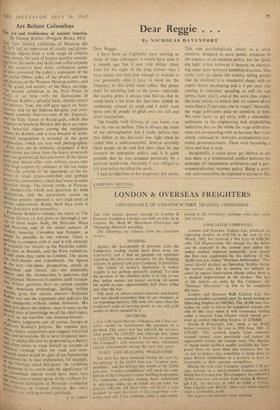Art Before Columbus
Tile Art and Architecture of Ancient America.
By George Kubler. (Penguin Books, 84s.) 1-112 Tate Gallery exhibition of Mexican Art '3( 1953 left an impression of cruelty and gloom. though objects from a wide range of cultures .''ere shown, the aura of human sacrifice emanat- trig from the masks and skulls and coiled serpents ar the country's final Aztec civilisation seems ;9 have prevented the public's enjoyment of the t,ar earlier Olmec jades, of the dwarfs and dogs ttr!rl dancers of the Western Mexican potters, and 0t. the grace and serenity of the Maya carvings. ante present exhibition in the Petit Palais in • rl-is, or an hour with the illustrations of e rofessor Kubler's splendid book, should correct the balance_ True„ one will gaze again on Aztec 'terrors, and on the hideous bat-gods and over- loaded symbolic funerary-urns of the Zapoteds, and the Xipe Totecs or flayed gods, which also originate in Southern Mexico. But there are many verY beautiful objects among the antiquities • chosen by Kubler, and a true breadth of archi- tectural imagination is revealed in the great temple-sites, which are very well photographed. Peru also can be seriously misjudged if first Mlpressions are taken from the heavy stonework ;Pit vast geometrical barrack-towns of the Incas. Peas and Aztecs alike were military castes who bolt huge empires by conquest in the last stages ore the coming of the Spaniards, at the ex- • ens'e of small priest-controlled and perhaps Peaceable communities, which had learnt to make beautiful things. The woven cloths of Paracas, the featherwork which was practised by both c,.ivilisations, and the naturalistic scenes on mochiea pottery represent a very high level of artistic achievement. Beside them Inca work is t‘rtss, derivative and insensitive. a Professor Kublefs volume, the latest in The "-lican History of Art, gives as thorough a sur- ‘,e5' of three major fields, the Mexican, Maya Central Peruvian, and of the minor cultures of `'-entral America, Colombia and Ecuador, as be possible in one volume. There is bila!thing to compare with it, and it will certainly essential for visitors to the Peruvian exhibi- ictn, now in Brussels, and the Paris exhibition, tE and When they come to London. The plates arc well-chosen and reproduced; the figures dill the textplans, perspectives, details of decoration and fresco, etc.--are admirably Caiwn; and the introduction is judicious and tie.° Planned. Moreover, it confines itself to essen- 2tS• Where questions have no certain answers records, American archxology, lacking written le(.e°erds, giveS few certain answers—Professor ettuier sets out the arguments and indicates his Co standpoint without undue insistence. His 07°k will please the student, since it sums up the alesent state of knowledge on all the chief topics, well as the traveller and museum-haunter. latasthetic judgments are, of course, foreign to eekessor Kubler's purpose. He explains pro- lia5e3es, makes connections and suggests historical e"'le"s and derivations. He is never prepared, how- Ye r, to chance his arm by propounding a theory, req,d Often seems to wrap himself in cocoons of t"bnical verbiage when the weak and unin- rit4cted reader would be glad of an illuminating • I'ttlisation. A clear explanation, for example, of the Mexican ritual ball-game, the variations i4P'41ThIng of its courts and the significance of weiCerervionial objects would have been very the`onie> also a summing-up of the evidence for froaltimate• derivation of Peruvian civilisation R>umblec are nothing to one's gratitude.
J. NI. COHEN


































 Previous page
Previous page